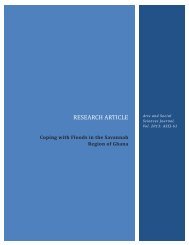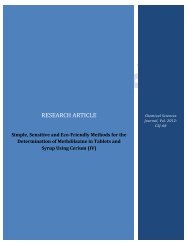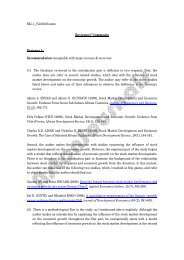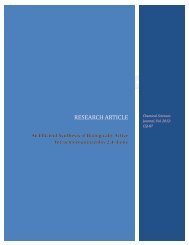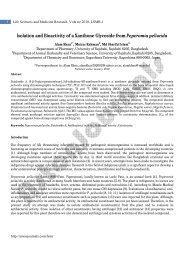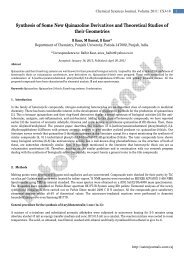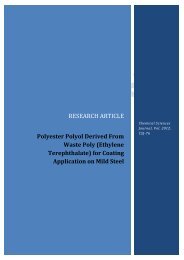Rapid and Sensitive Spectrophotometric ... - AstonJournals
Rapid and Sensitive Spectrophotometric ... - AstonJournals
Rapid and Sensitive Spectrophotometric ... - AstonJournals
You also want an ePaper? Increase the reach of your titles
YUMPU automatically turns print PDFs into web optimized ePapers that Google loves.
Chemical Sciences Journal, Vol. 2012: CSJ-80<br />
1<br />
<strong>Rapid</strong> <strong>and</strong> <strong>Sensitive</strong> <strong>Spectrophotometric</strong> Measurement of Non-<br />
Specific Beta Blocker Propranolol Hydrochloride Using Three<br />
Sulphonphthalein Dyes In Pure Form, Pharmaceuticals<br />
<strong>and</strong> Human Urine<br />
KN Prashanth, K Basavaiah*, MS Raghu<br />
Department of Chemistry, University of Mysore, Mysore, Karnataka, India.<br />
*Correspondence to: Kanakapura Basavaiah, basavaiahk@yahoo.co.in<br />
Accepted: Nov 13, 2012; Published: Nov 24, 2012<br />
Abstract<br />
Three sensitive, selective, rapid <strong>and</strong> easily reproducible spectrophotometric methods (A-C) have been developed for the<br />
determination of propranolol hydrochloride (PPH) as a hydrochloride free base propranolol (PPL) in bulk sample <strong>and</strong> in its<br />
dosage forms. These methods are based on ion-pair formation between propranolol as a hydrochloride <strong>and</strong> free base <strong>and</strong> three<br />
acidic (sulphonphthalein) dyes; namely bromothymol blue (BTB), bromocresol green (BCG) <strong>and</strong> bromocresol purple (BCP) which<br />
induces an instantaneous bathochromic shift of the maximum in the drug spectrum. The colored products are measured at 420<br />
nm (PPL-BTB complex <strong>and</strong> PPL-BCP complex) <strong>and</strong> 425 nm (PPL-BCG complex). The reactions were extremely rapid at room<br />
temperature <strong>and</strong> the absorbance values remained constant for 90 min (method B), <strong>and</strong> over 24 hrs (method A <strong>and</strong> C).<br />
Conformity to Beer’s law in the range 0.4-7.0 µg ml -1 for methods A <strong>and</strong> B <strong>and</strong> 0.5-8.4 µg ml -1 for method C enabled the assay of<br />
dosage forms of the drug. The proposed methods were compared with a reference method; the results obtained were of equal<br />
accuracy <strong>and</strong> precision. In addition, these methods were also found to be specific for the analysis of PPH in the presence of<br />
excipients, which are co-formulated in the drug. Satisfactory results were obtained when applied to spiked human urine. A<br />
more detailed investigation of the propanolol hydrochloride ion pair complexes were made with respect to its composition<br />
indicated by stability constant values.<br />
Keywords: Propranolol hydrochloride; spectrophotometric assay; ion-pair complexes; pharmaceuticals; human urine.<br />
1. Introduction<br />
Propranolol hydrochloride (PPH), (2RS)-1-[(1-Methylethyl)amino]-3-(naphthalen-1-yloxy)propan-2-ol hydrochloride<br />
(Figure 1), is a highly effective antihypertensive <strong>and</strong> antianginal drug. Being a nonselective prototype betaadrenergic<br />
receptor-blocking agent, it possesses no other autonomic nervous system activity <strong>and</strong> specifically<br />
competes with beta-adrenergic receptor-stimulating agents for available receptor sites. The drug is widely used in<br />
clinical practice for the treatment of cardiac arrhythmia, hypertension <strong>and</strong> angina pectoris [1], dysfunctional<br />
labour, anxiety <strong>and</strong> migraine [2, 3]. It is also abused in sports involving little physical activity to reduce cardiac,<br />
contraction, heart rate <strong>and</strong> coronary blood flow [4]. Therefore, it has been included in the list of forbidden<br />
substances by the International Olympic Committee [5]. Monitoring of propranolol in biological fluids is important<br />
not only in clinical practice but also in the field of doping control. The drug is official in BP [6] <strong>and</strong> USP [8], which<br />
describe UV-spectrophotometric methods for the assay of PPH after extraction into methanol, <strong>and</strong> also in IP [7]<br />
which describes a potentiometric titration of drug in ethanol with 0.1 M NaOH.<br />
O<br />
OH<br />
N<br />
H2<br />
.Cl<br />
Figure 1: Structure of propranolol hydrochloride.<br />
http://astonjournals.com/csj



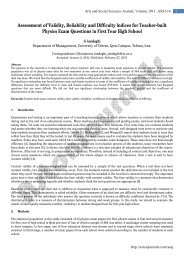
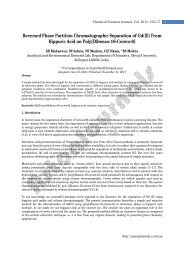
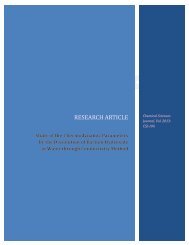
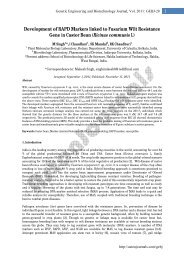

![[1,4]-benzodiazepine-2-one Derivatives as Potent - AstonJournals](https://img.yumpu.com/49117784/1/184x260/14-benzodiazepine-2-one-derivatives-as-potent-astonjournals.jpg?quality=85)
